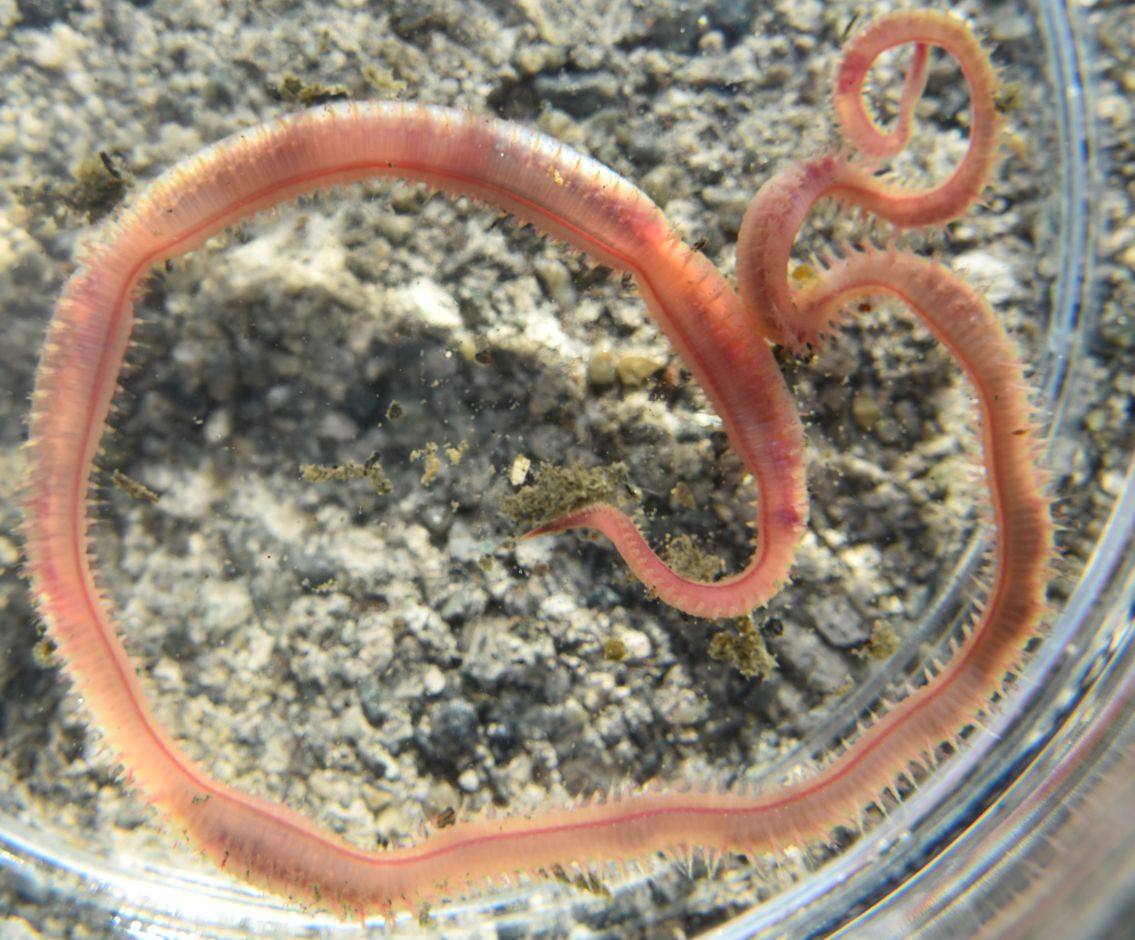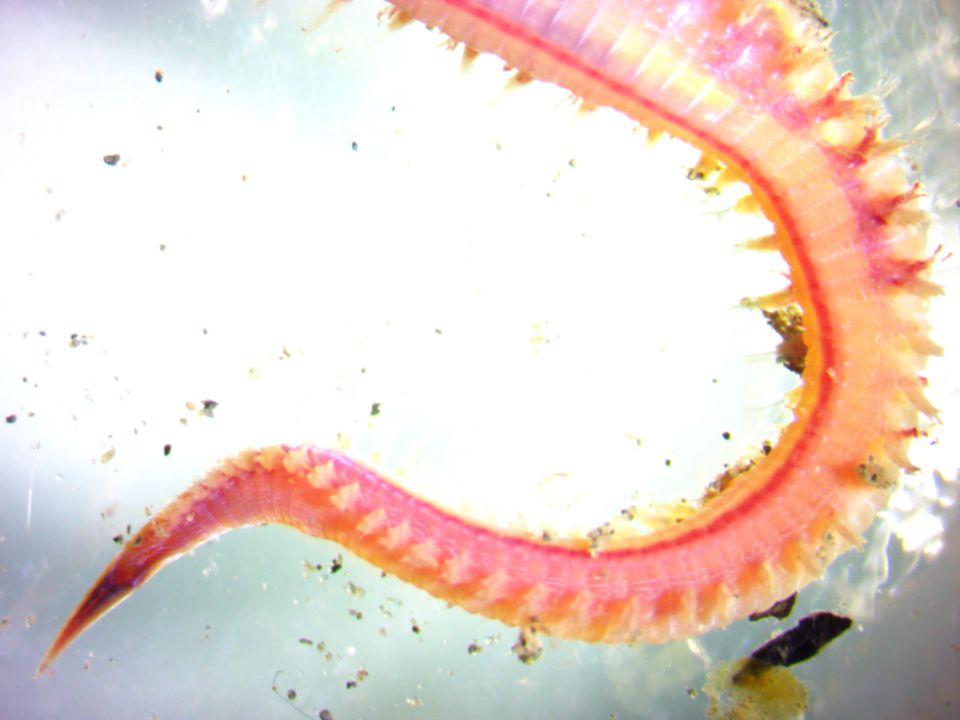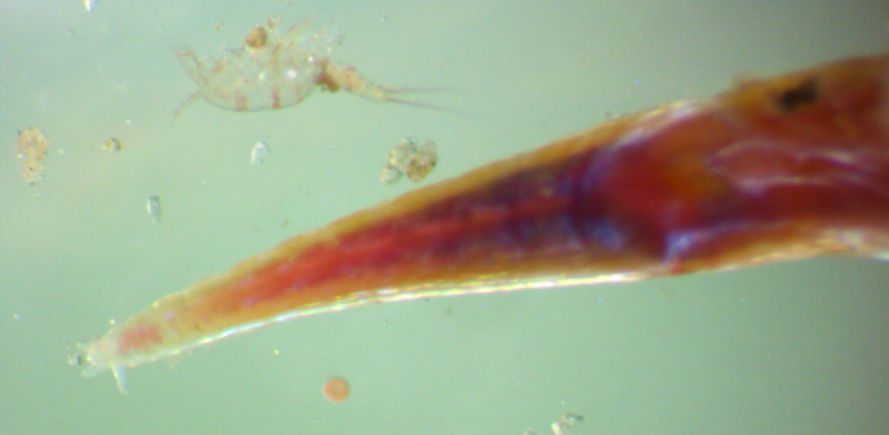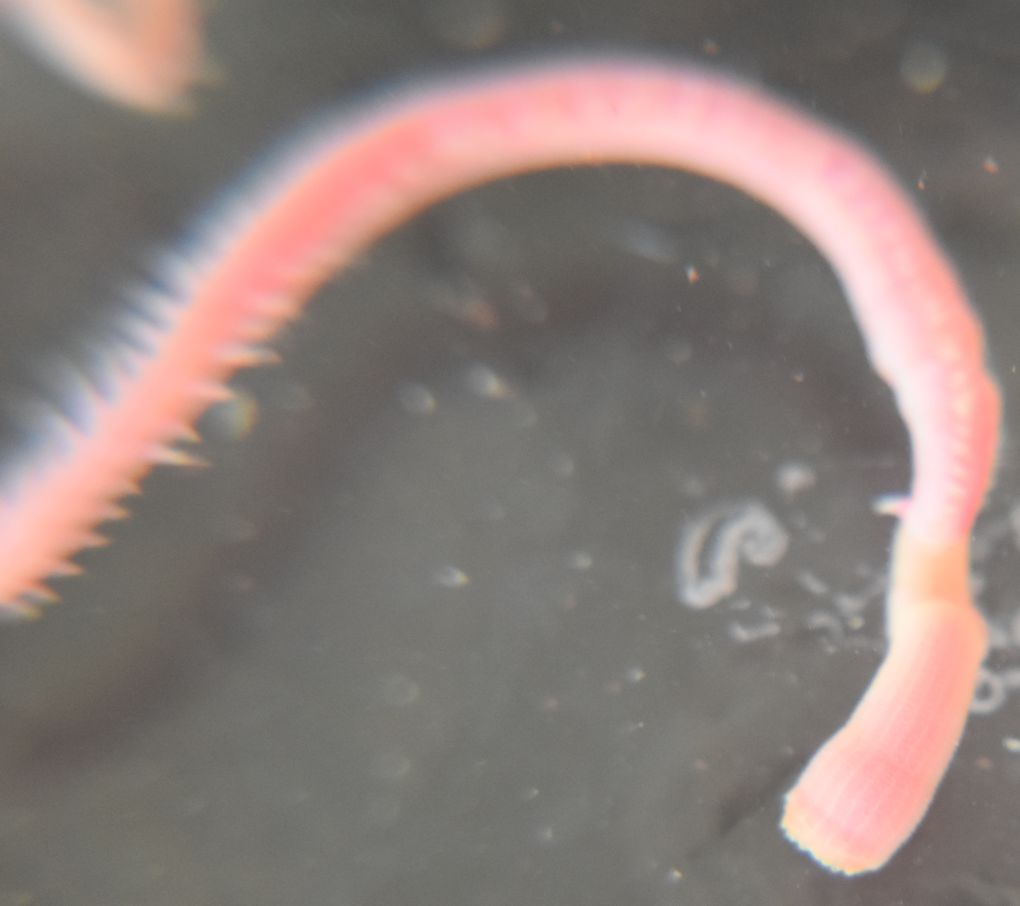Glycera americana Leidy, 1855Common name(s): American bloodworm, Proboscis worm, Corrugated worm |
|
| Synonyms: |  |
|
Phylum Annelida
Order Phyllodocida
Superfamily Glyceracea
|
|
| Glycera americana, about 15 cm long, from sediment collected at 15-20 m depth in Burrows Bay by Katie Pekar in the summer of 2018. The head, which tapers to a pointed prostomium tip, is in the middle of the large loop. Note that the body tapers gradually smaller toward the posterior end. | |
| (Photo by: Dave Cowles, August 2018) | |
Description: Family Glyceridae (bloodworms) is a distinctive family of benthic polychaetes with a prostomium that is shaped like a cone (as if the face of the animal is covered by a funnel), tapered to a point (often with annulated rings), and with 4 tiny antennae (sometimes damaged or hard to see) at the tip (photo). Sometimes eyes are apparent. Their pharynx, when everted into a proboscis, has 4 hook-like jaws and can be up to 1/3 the length of the animal. Glycera americana has biramous parapodia (except for the first 2 pairs), which have 2 presetal and 2 postsetal lobes. It also has long, branched, fingerlike, retractile gills on the posteriodorsal surfaces of the parapodia (if the gills are partly retracted it may not be evident that they are branched, and if fully retracted they may appear only as a thin, loose patch of epidermis on the parapodium). The notosetae are simple but the neurosetae are compound (composed of more than one section). Segments are clearly wider than long. Nearly all body segments except the first two are similar, but the body tapers gradually toward the posterior end. Total length to 35 cm, not c Glycera_americana.html ounting the everted pharynx. Color usually iridescent pink or greenish-blue.
How to Distinguish from Similar Species: The shape and location of the gills is characteristic for this species. Several other Glycera species have no gills, have globular or blister-shaped gills, or the gills arise from the anterior or dorsal part of the parapodia. Family Goniadidae also have a funnel-shaped prostomium with 4 small antennae but have only 2 large jaws and 2 groups of smaller jaws on their everted pharynx. Their bodies are also divided into 2-3 distinct regions while most segments except the first two of Glycerids are similar.
Geographical Range: Pacific coast of North and South America from British Columbia to Chile; also Japan, Australia, and New Zealand. On the Atlantic coast from Canada to Brazil.
Depth Range: Intertidal to 315 m depth
Habitat: Burrows through mixed sand/mud ; sometimes under rocks or among the roots of eelgrass.
Biology/Natural History: This worm is a rapid burrowing predator and readily everts its long, cylindrical, fanged pharynx both to capture prey and to pull itself through soft sediment. The jaws on the pharynx are venemous with a neurotoxin that includes serotonin and proteolytic enzymes and can cause inflammation in humans. Its main prey is other polychaetes. Since its anus appears to be nonfunctional, after a meal it regurgitates the undigested portion through the pharynx. When sexually mature (in summer) the animal loses its pharynx and its body fills with gametes. It then swarms up into the water column as an epitoke in a breeding swarm with other epitoke individuals of its species. It releases its gametes through its mouth or bursting out through the skin, then dies.
Members of Famuily Glyceridae are called bloodworms because if they
are cut they often release large quantities of bright-red blood or coelomic
fluid. The red color of the fluid is due to hemoglobin which is contained
within red corpuscles.
| Return to: | |||
| Main Page | Alphabetic Index | Systematic Index | Glossary |
References:
Dichotomous Keys:Carlton, 2007
Kozloff, 1987, 1996
General References:
Harbo, 2011
Lamb and Hanby, 2005
Morris et al., 1980
Scientific Articles:
Web sites:
General Notes and Observations: Locations, abundances, unusual behaviors:

Another view of the anterior end. The head with tapering prostomium
is at the bottom left. Note the large, blood-red dorsal
vessel visible through the dorsal
surface of the animal.

In this close-up view of the prostomium
the tiny tentacles at the tip and the annulated rings can be seen.

In this image the large, cylindrical pharynx
is partly everted. If
everted further the black,
hook-like fangs would appear.

This ventral view
of the right side of 3 segments of the animal shows the branched, fingerlike,
blood-filled gills which
project from the posterodorsal
part of the parapodia.
The long, golden-brown setae
projecting from the parapodia
can be seen to the right (posterior
side) of each gill tuft. This movie shows the blood coursing through the gills.
Authors and Editors of Page:
Dave Cowles (2018): Created original page
CSS coding for page developed by Jonathan Cowles
Salish Sea Invertebrates web site provided courtesy of Walla
Walla University